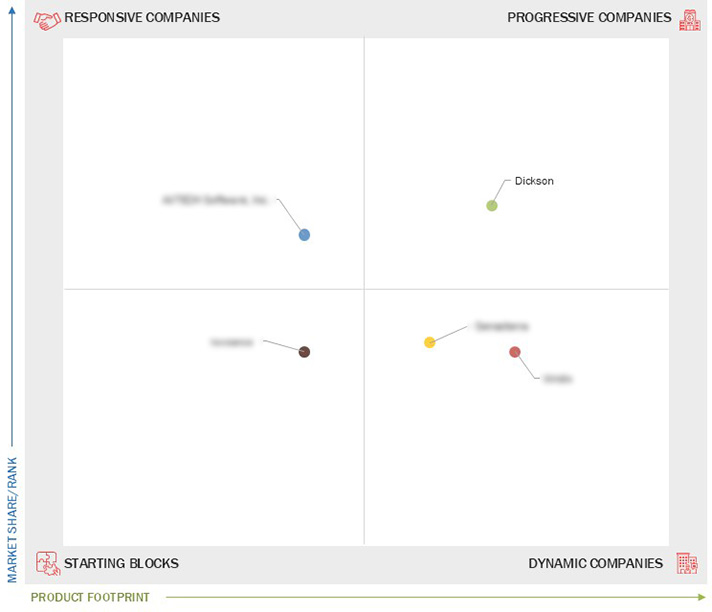Comparing 5 vendors in Humidity Sensor Startups across 0 criteria.
A humidity sensor is a device designed to measure and monitor moisture levels in the air, ranging from handheld models to components integrated into air quality systems. Using a sensing element, often a thermistor, these sensors convert data into electrical signals to display humidity levels. They measure either relative humidity (RH) or absolute humidity (AH). RH compares current humidity to its maximum at a given temperature, while AH measures water vapor volume in grams per cubic meter.
Market Leadership Quadrant
1.1 Study Objectives
1.2 Market Definition
1.3 Study Scope
1.3.1 Markets Covered and Regional Scope
1.3.2 Inclusions and Exclusions
1.3.3 Years Considered
1.4 Currency Considered
1.5 Unit Considered
1.6 Limitations
1.7 Stakeholders
2.1 Introduction
2.2 Market Dynamics
2.2.1 Drivers
2.2.1.1 Increasing demand for efficient and compact sensors
2.2.1.2 Rising need for precise environmental monitoring solutions
2.2.1.3 Increasing requirement for humidity control in printing
processes
2.2.2 Restraints
2.2.2.1 Incompatibility of legacy systems with contemporary digital
humidity sensors
2.2.2.2 Sensor drift and other performance issues
2.2.3 Opportunities
2.2.3.1 Rapid advances in printed humidity sensors
2.2.3.2 Growing demand for calibrated humidity sensors for cost-
effective applications
2.2.4 Challenges
2.2.4.1 Sensor design complications due to lack of uniform
standards
2.2.4.2 Requirement for substantial investments in advanced
materials and sophisticated engineering approaches
2.3 Value Chain Analysis
2.4 Ecosystem Analysis
2.5 Investment and Funding Scenario
2.6 Trends/Disruptions Impacting Customer Business
2.7 Technology Analysis
2.7.1 Key Technologies
2.7.1.1 Gravimetric humidity sensing
2.7.1.2 Nanomaterial-based sensors
2.7.1.3 Flexible electronics
2.7.2 Complementary Technologies
2.7.2.1 Calibration technologies
2.7.2.2 Wireless communication modules
2.7.3 Adjacent Technologies
2.7.3.1 Environmental simulation chambers
2.8 Impact of AI/Gen AI on Humidity Sensor Market
2.8.1 Introduction
2.8.2 Top Use Cases of AI/Gen AI in Humidity Sensor Market
2.8.2.1 Predictive maintenance
2.8.2.2 Quality control in manufacturing
2.8.2.3 Early warning systems
2.8.2.4 Smart calibration
2.8.2.5 Energy efficiency optimization
2.8.3 Best Practices
2.8.3.1 Smart agriculture
2.8.3.2 Industrial process control
2.8.3.3 Healthcare and medical devices
2.8.3.4 HVAC and building management
2.8.3.5 Food and pharmaceutical storage
2.9 Porter’s Five Forces Analysis
2.9.1 Threat of New Entrants
2.9.2 Threat of Substitutes
2.9.3 Bargaining Power of Suppliers
2.9.4 Bargaining Power of Buyers
2.9.5 Intensity of Competitive Rivalry
3.1 Overview
3.2 Key Player Strategies/Right to Win, 2021–2024
3.3 Revenue Analysis, 2019–2023
3.4 Market Share Analysis, 2023
3.5 Company Valuation and Financial Metrics, 2024
3.6 Product Comparison
3.7 Company Evaluation Matrix: Startups/SMEs, 2024
3.7.1 Progressive Companies
3.7.2 Responsive Companies
3.7.3 Dynamic Companies
3.7.4 Starting Blocks
3.7.5 Competitive Benchmarking: Startups/SMEs, 2023
3.7.5.1 Detailed list of key startups/SMEs
3.7.5.2 Competitive benchmarking of key startups/SMEs
3.8 Competitive Scenario
3.8.1 Product Launches
3.8.2 Deals
4.1 AVTECH Software, Inc.
4.1.1 Business overview
4.1.2 Products/Solutions/Services offered
4.1.3 Recent developments
4.2 Dickson
4.2.1 Business overview
4.2.2 Products/Solutions/Services offered
4.2.3 Recent developments
4.3 Novosense
4.3.1 Business overview
4.3.2 Products/Solutions/Services offered
4.3.3 Recent developments
4.4 Sensoterra
4.4.1 Business overview
4.4.2 Products/Solutions/Services offered
4.4.3 Recent developments
4.5 Viridix
4.5.1 Business overview
4.5.2 Products/Solutions/Services offered
4.5.3 Recent developments


 Providence Business News
Providence Business News
 Jun 2025
Jun 2025

